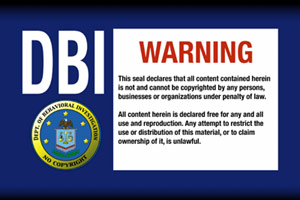Revaluing Value: The Condition of Copyright

The Department of Behavioural Investigation's No Copyright Seal.
Copyright laws have always been a contentious issue. These laws are designed to provide economic protection for persons' and businesses' "intellectual property", which is defined by the World Intellectual Property Organization as "…creations of the mind: inventions, literary and artistic works, and symbols, names, images, and designs used in commerce." Copyright is designed for inventors, artists, writers, and musicians to ensure that they are compensated monetarily when their work is reproduced and/or distributed. As it applies to art, copyright reinforces the value of authenticity. It ensures that a particular image or sound can be designated as the original (i.e. authentic), and that any reproduction of these items will be designated as a copy. This hierarchy establishes the value of the original as the point of reference by which the value of a reproduction is determined. This relies on a scarcity model, which means that if there is more of something, it is less valuable in general. This gives the object a capital and hence economic value. Copyright laws rely on this presumption, and posit that the value of an idea is primarily measured in economic terms.
As tools for the reproduction and distribution of art become more available, this value has to be reformulated to account for the changing needs of artists and their audiences. In many cases artists are producing work in which the copy is of primary importance, or in which there is no original proposed at all. There is a difference in how such a product is valued - rather than valuing it as an object that can be sold, and therefore benefited from monetarily, the object's value lies in how it is distributed and used. If I write a book and I decide that it is more important for people to read the book than to pay for it, I formulate the value of the book as one of information. In a broader sense, I privilege the value of the book's content entering the public sphere rather than the potential monetary gains of its distribution. Copyright as it exists today is unable to account for these different expressions of value. It is diametrically opposed to valuing an object differently because it is designed to formulate value only in terms of ownership and authenticity. Intellectual property must be reevaluated and revalued by the artists whose work challenges its principles.
Artists Revaluing Copyright
For artists who believe that copyrighting their work restricts viewers' access to it, and that accessibility is central to the success of their art, there exists a "No Copyright Seal." The No Copyright Seal can be obtained from a website and once put on a piece of intellectual property, "[ensures] that it cannot be copyrighted by any person, business or organization; not even you."
The seal itself comes from an interesting place: the Department of Behavioural Investigation, whose mission is "to provide everyone the opportunity to voice their dissent, dissatisfaction and disgust with their government, their community, and their daily lives." Sound strange? The DBI is actually a continuing art project that functions as a satirical yet serviceable institution (of the anti-institutional variety). Created by Lawrence Mesich, the DBI operates as a temporary office in art galleries, and sponsors workshops, instructional videos, and activity kits for viewers to use to protest issues such as community garbage, institutional uses of space, or surveillance cameras and privacy infringement. The pieces only operate if "volunteers" are copying and carrying out the plans outlined by the DBI. Not only is the DBI copyright free, it needs to be copyright free in order to function.
There are now multitudes of art and music projects that are based on anti-copyright ideas.
The band Negativland, which is just as much a conceptual art piece as a
band, operates by appropriating sound, image, and text in a such a way
as to just barely miss the requirement of fair use. They exist in the
grey area of copyright laws in order to comment on both the laws
themselves and the source materials they have appropriated. The term
"culture-jamming" was originally coined by the group to explain their
appropriation process. They now have a radio show called "Over the
Edge" where listeners can "deposit their programming into the mix" by
calling in. Negativland also "manages" the Intellectual property Fund
of «™ark (read: Art Mark). «™ark an activist institution much like the
DBI made by the same people who head The Yes Men (see November 6, 2004
issue), which funds "corporate products sabotage and intellectual
property disobedience."
In an atmosphere of art and digital culture that is beginning to blur the boundaries between the gallery and the public sphere, and, more specifically, using appropriation and interaction as some of its primary functions, the idea of strict copyright is not only contradictory and inappropriate, but is also becoming cannon fodder for subject matter.
The DBI currently has a temporary office at The Staller Gallery at Stonybrook University, NY from March 5 to April 9, 2005.
You can get your No Copyright Seal at http://emedia.art.sunysb.edu/lawrence/dbimo.html
Negativland will play at "Open Ears," a festival of music and sound
to be held in Kitchener, Ontario, from April 6 to May 1, 2005.
Information on how to contribute to Over the Edge can be found at http://www.negativland.com/ote_live/
╗ Email this article to a friend
╗ Go to the current issue of the Dominion
╗ Read new articles from around the web at the Dominion weblog